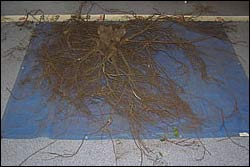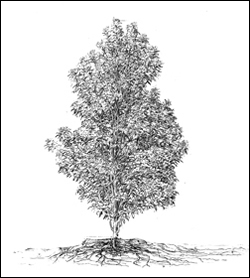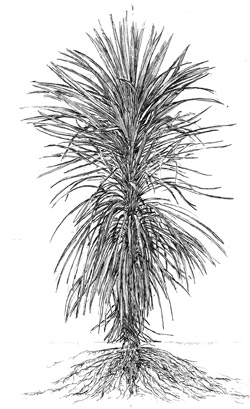Stabilising characteristics of native plants
Research Status: Ongoing |
Native plant root system |
Introduction
In the settlement of New Zealand, much native riparian vegetation was cleared for agriculture and urban development. As a consequence the ecosystem services provided by riparian vegetation were lost or seriously compromised.
Services such as stabilising stream banks, filtering runoff, shading and protection of fish habitats, enhancing aesthetics and controlling downstream flooding, are vital for healthy streams and coastal waterways. Of these services, bank stabilisation is often regarded as being of high importance because, without it, many of the other services may be limited by erosion and its consequences
In New Zealand, and for that matter in other parts of the world, there is currently a strong lobby to improve indigenous biodiversity. This is reflected in a wide range of initiatives, policies, and plans at every level of governance but perhaps is more strongly reflected in a ground-swell of community action to revegetate "their place".
However, in New Zealand at least, all these activities are set against a backdrop of poor information about the stabilising characteristics of plants used in these restoration efforts. In general, information on the below-ground characteristics of plants is pretty lean worldwide. This is largely due to the costly and time-consuming effort required to examine the root systems of plants, particularly those of trees. This research is aimed at providing this information for some of our native plants.
Research Approach
Nursery-raised plants were assessed for years one and two and a field trial was established to obtain growth data for older-aged plants. The plot (60 m Ã- 15 m) was on flat alluvial land near Gisborne, East Coast, North Island. The topsoil is a black, very friable sandy loam with a weakly developed structure of fine granules, with a layer of loose sand beneath. The soil is free draining to a depth of 2 m and requires irrigation in summer.
Before planting, the plot was sprayed, ploughed and covered with weed mat. Twelve trees of each species were planted randomly in blocks, 10 of which were extracted each year for the next 3 years according to age. The 2- and 3-year-old blocks are planted at 1m spacing and the 4- and 5-year-old blocks at 1.5-2.0 m spacing. The trees were irrigated for the first three months after planting.
We selected 10 specimens of each species at each age and looked at a range of variables which includes: canopy spread, root depth, lateral root spread, above and below ground biomass, tree height and so on.
In the first trial (completed in 2004) we have examined 12 native plant colonisers for their ability to stabilise stream banks. These plants are part of the early succession as well as being some of the key species used in stream-side restoration projects. They were:
Karamu (Coprosma robusta), Ribbonwood (Plagianthus regius), Kowhai (Sophora tetraptera), Lemonwood (Pittosporum eugenoides), Kohuhu (Pittosporum tenuifolium), Lacebark (Hoheria populnea), Mapou (Myrsine australis), Fivefinger (Pseudopanax arboreus), Cabbage tree (Cordyline australis), Rewarewa (Knightia excelsa), Manuka (Leptospermum scoparium), Tutu (Coriaria arborea).
In the second trial that comenced in 2006, we have focused on podocarps but also included a number of non-woody species such as flax, carex and toe toe.
Research Results
The mean maximum root depths sorted on Year 5 data, show there is considerable overlap between species. Mean root depth varied from 20 to 45 cm.Cabbage tree exhibited the greatest root depth at around 45 cm, after 5 years.
Lateral root spread data, like root depth, shows variation between species. Root spread in Year 5 ranged from 100-300 cm. Tutu, lemonwood, and ribbonwood had twice the root spread of some other species. The general pattern in above- and below-ground biomass is much the same as for root depth and root spread with a lot of overlap but one or two top performers which are significantly different from the others at the 95% confidence level. Cabbage tree and tutu were the top performers at year 5.
To summarise these preliminary results, we find that for an individual plant species, its "performance" relative to the other species changes according to the parameter in question. While most of the trial species exhibited similar values for each parameter for the first 2 years of growth, ribbonwood outperformed all the species for two parameters - above- and below-ground biomass - and was second to tutu in lateral root spread. The relative position of these species changed as the plants grew and at age 5 cabbage tree was a top performer for a number of growth attributes.
Root studies of plants less than 2 years old, are commonly affected by factors in their early life in the wild or in the nursery such as wrenching, root training and constriction in planter bags. It is likely that these factors may have contributed to some of the the early differences seen in the data, rather than the results being truly representative of an inter-species difference.
The trial was completed in 2004 when the plants were 5 years old. Posters are available for downloading that provide summaries of the key parameters for each species studied - Trial 1 and Trial 2 .
In terms of using these results when carrying out native plant restoration there is a rider - please read this caution.
 |
 |
5-year old lemonwood |
5-year old cabbage tree |
Recent Publications
Recent Presentations
BMPs, BEPs and Guidelines
| Title | Description |
| Southland’s Wetlands assessment Guide | A tool kit for use by landowners that includes practical advice and assistance to encourage the main...More » |
| Best practice guidelines for vegetation management and in stream works | These best practice guidelines cover activities undertaken by the River and Catchment Services group...More » |
| Protecting and Restoring our Natural Heritage – a Practical Guide |
From website: This guidebook provides information on protection, management and restoration of...More » |
| Riparian Zone Management Guidelines |
From document: This Guideline is a practical manual for use by landowners, developers, organis...More » |
| Riparian Zone Management Planting Guide | Companion Guide to "Riparian Zone Management Guidelines"...More » |
| Native Plants for Streamsides in Wellington Conservancy |
Guideline helps reduce further loss of indigenous biodiversity by indicating the native plants ...More » |
| Trees on Farms: A guide with local experience of growing trees in the Waikato Region |
From website: This manual covers a range of aspects of selection, establishment and care of tr...More » |
| Wind Erosion and Control |
From manual: Explains how wind erosion occurs, and outlines techniques to manage it. More » |
| Restoring the Balance: Biodiversity self–help kit |
From kit: This resource kit aims to help you – Identify the existing biodiversit...More » |
| Streamside Planting Guide |
From website: The streamside planting guide will help you know what to plant where, and how to...More » |
Primary Contacts:

|
Michael Marden
Email Phone: 06 8631345 Fax: 06 8631346 More details» |
Institute Landcare Research |
Expertise Geology/Earth Sciences/Geomorphology/Erosion processes |

|
Chris Phillips
Email Phone: +64 3 321 9775 More details» |
Institute Landcare Research |
Expertise Erosion processes, slope stability, effects of forestry, catchment management, knowledge management |